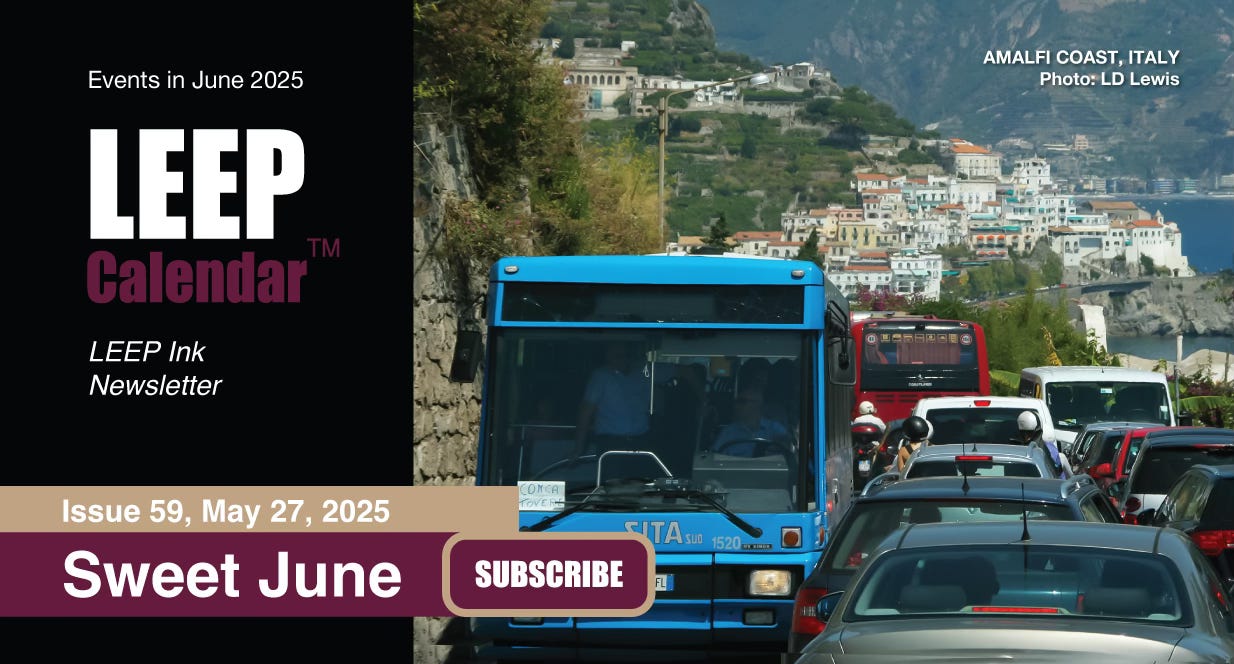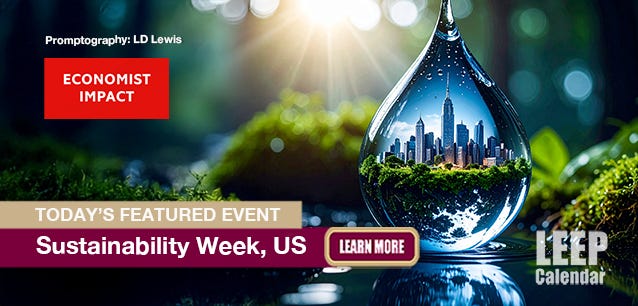 AD
AD

Sweet June 2025
The solstice on the 20th marks the onset of summer (Northern Hemisphere) or winter (Southern Hemisphere). Many people, particularly in Europe, North America and Asia, will be embarking on holidays, meaning tourism is a major theme.
In the United States, we are about to see something we'd never thought we'd have to endure: a military parade down Pennsylvania Avenue in the heart of Washington DC—on Flag Day, June 14—which I guess is our president's birthday.
Additionally, this anomaly in the White House has plastered his face on banners and buildings in DC. For a second there, I thought I was driving through Bahrain, where the royal family loves to put their faces on multi-story banners on the side of buildings. As an American, I find it highly distasteful and anathema to our values, customs and culture that a president would do either the parade or the building banners. Therefore, other than this mention, I'm not adding this multi-million dollar waste of taxpayer money and tyrannical tribute to self-aggrandizement to LEEP.
Traditionally, June is Pride Month, marking the anniversary of the Stonewall Riots in 1969. Usually, the President of the United States declares it. This year we're not sure. Nor are we sure about Juneteenth, on the 19th, which was made a federal holiday under Biden. However, both are based on historical events. Pride Month is recognized globally; the rainbow shall continue to shine regardless of what the White House says. Juneteenth will continue its celebration of freedom, just the same.
It's International Men's Month, which embraces men, fatherhood and their health and societal needs. Caribbean-American Heritage Month and Immigrant Heritage Month in the United States bring attention to two important demographics. Elsewhere, in Canada and several other nations, the focus is on Indigenous people and their history.
For more events, check out my June 2022, June 2023 and June 2024 editions. Let's start this issue off with sustainability.
The world in a drop of water, representing the hope of the Sustainability Conference—promptography LD Lewis.
SUSTAINABILITY WEEK CONFERENCE
Date: June 11-12, 2025
Location: New York City, United States
Champion: The Economist Magazine
Economist Impact’s Sustainability Week Conference brings together sustainability professionals, policymakers, and innovators to discuss the intersection of economic growth and environmental responsibility. Organized by The Economist Magazine, the event features more than 150 expert speakers and 50 real-world case studies exploring how clean energy, SMART technologies, and strategic investments can shape a sustainable future.
Participants engage in in-depth discussions on renewable energy, sustainable agriculture, and the powering of AI and data centers. The conference equips attendees with actionable strategies for maintaining competitiveness amid environmental challenges while providing extensive networking opportunities. The highlight is the Energy Transition Summit, which focuses on enhancing corporate resilience and minimizing operational downtime in an evolving energy landscape.
Dia dos Namorados is a favorite holiday in Brazil. Promptography—LD Lewis
DIA DOS NAMORADOS (DAY OF THE LOVERS)
Date: June 12, 2025
Location: Brazil
Champion: Brazilian Tradition
Brazil's Dia dos Namorados, or "Lovers' Day," is set apart from Valentine's Day by its spiritual connection to Saint Anthony, Brazil's patron saint of marriage. The holiday was created in 1948 by publicist João Doria, who, working with a department store, launched a campaign to boost June sales. His slogan, "Love is not only proven with kisses," linked emotional affection to gift-giving. Despite its commercial roots, Dia dos Namorados has become a deeply cherished part of Brazilian culture, reflecting the nation's warmth and emotional vibrancy.
Couples celebrate by exchanging flowers, chocolates, and romantic gestures, with events, dinners, and retail promotions enhancing the festive atmosphere. Urban centers often mark the day with elaborate surprises, while smaller towns favor more intimate traditions. Beyond romance, the day highlights love as a vital force in Brazilian life and a shared cultural value. Its economic impact is substantial, and its cultural significance runs deep—expressing love in all its forms as a defining feature of Brazilian identity.
Xi Shai Jie, or the Bathing and Basking Festival, is a traditional holiday in China—promptography LD Lewis.
XI SHAI JIE (BATHING & BASKING FESTIVAL)
Date: June 30, 2025
Location: China
Champion: Chinese Tradition
Xi Shai Jie, or the Bathing & Basking Festival, is an annual celebration held by the Bouyei ethnic minority in China’s Guizhou Province. Observed on the sixth day of the sixth lunar month, the festival honors nature, health, and community through centuries-old water purification and sun worship traditions. The central ritual involves communal bathing in rivers or springs, symbolizing spiritual cleansing and protection from illness, then sunbathing.
The festival features vibrant food and cultural displays, traditional dishes like glutinous rice dyed with natural plants, zongzi (sticky rice dumplings), river fish, and fresh fruit. Families gather for outdoor feasts, and villages come alive with singing, bamboo dancing, bullfighting, embroidery showcases, and sports competitions. Xi Shai Jie serves as a bridge between generations, preserving ancestral customs while uniting communities in joy and tradition.
Portrait of General don Martín Miguel de Güemes by artist Eduardo Schiaffino.
GENERAL DON MARTÍN MIGUEL DE GÜEMES DAY
Date: June 17, [1821]
Location: Argentina
Champion: Historical Anniversary. National Holiday.
Don Martín Miguel de Güemes (1785-1821), a hero of the Argentinian Civil War against Spain. Güemes Day is a national holiday in Argentina.
Born on February 8, 1785, in Salta, Martín Miguel de Güemes grew up in a wealthy, noble family. He received a formal education and entered military service at a young age. At just 23, he gained fame during the British Río de la Plata invasion by capturing a British ship using only local cavalry, earning admiration for his ingenuity and valor. Güemes emerged as a key military and political leader during the Argentine War of Independence.
Appointed governor of Salta in 1815, he led the Gaucho War, a series of guerrilla campaigns that successfully defended the northwest frontier from repeated Spanish incursions. Utilizing local gaucho militias—rural horsemen familiar with the mountainous terrain—Güemes devised unconventional strategies that stalled royalist advances and protected the rest of the revolutionary territory. His efforts were instrumental in preventing the Spanish from regaining control of Argentina. He was mortally wounded in battle on June 7, 1821, and died ten days later.
World Scleroderma Awareness Day marks the death anniversary of cubist painter Paul Klee on June 29, 1940.
WORLD SCLERODERMA AWARENESS DAYS
Date: June 29, [1940]
Location: Worldwide
Champion: Scleroderma Foundation
World Scleroderma Awareness Day and World Scleroderma Awareness Month bring awareness to this autoimmune condition through fundraising events and public outreach.
Scleroderma is an autoimmune disease that causes the skin and internal organs to thicken and tighten, leading to organ failure and death. This medical condition has no cure. The date marks the anniversary of the death of Swiss painter, known for cubism, Paul Klee on June 29, 1940, who died from the disease.
Sorghum is a staple grain in African food—Promptography LD Lewis
SORGHUM MONTH
Date: June 1-30, 2025
Location: United States
Champion: World Grain Council
Sorghum, a grain known for its resilience and versatility, has a rich history that spans several continents and thousands of years. In Africa, specifically the northeastern regions, sorghum has been a staple crop for millennia, dating back to approximately 3000 BC in ancient Egyptian civilizations. Its ability to thrive in arid and semi-arid regions made it a vital crop for societies in these harsher climates.
Sorghum's journey from Africa to other parts of the world is a story of agricultural adaptation and cultural exchange. Traders introduced the grain to the Middle East and Asia along ancient trade routes, where it became an important food source in these regions as well. Later, traders brought it to the Americas during the transatlantic slave trade, where it adapted well to the southern United States and integrated into American agricultural systems. In terms of its culinary uses, sorghum is incredibly versatile.
African cuisine features sorghum in traditional dishes such as porridge, bread, and fermented beverages. In the United States, cooks used it as a sweetener, with sorghum syrup being a popular alternative to sugar cane syrup in the South. The grain's mild, nutty flavor makes it a suitable ingredient for various dishes, and it cooks and works into recipes as a replacement for rice or quinoa.
Graphic of flags of the world.
ANNIVERSARIES AROUND THE GLOBE
Constitution Day
-
Denmark: June 5, 1849, 1953
-
Seychelles: June 18, 1993
-
Ukraine: June 28, 1996
Democracy Day
-
Nigeria: June 12, 1999
Independence Day
-
Croatia: June 25, 1991
-
Democratic Republic of Congo: June 30, 1960
-
Djibouti: June 25, 1977
-
Iceland: June 17, 1944
-
Madagascar: June 26, 1960
-
Mozambique: June 25, 1975
-
Philippines: June 12, 1898
-
Seychelles: June 29, 1976
-
Samoa: June 1, 1962
National Day
-
Greenland: June 20, 1983/2009
-
Luxembourg: June 23, 1921
-
Sweden: June 6, 1523/1809
-
Slovenia: June 25, 1991
-
The Congo: June 10, 1991
Republic Day
-
Italy: June 2, 1946
Victory Day
-
Estonia: June 23, 1919
-
Graphic of sport symbols.
MAJOR SPORTING EVENTS IN JUNE
June 2025 features a number of novel and exciting sporting events around the globe.
-
24 Hours of Le Mans (Auto Racing): June 11-15, 2025 —France
-
Belmont Stakes (Horse Racing): June 7, 2025 —United States
-
Calcio Storico Fiorentino (Specialty): June 24, 2025 —Italy
-
FIFA Club World Cup (Football): June 15-July 13, 2025 —United States
-
Grand Prix of Austria (Auto Racing): June 29, 2025 —Austria
-
Grand Prix of Canada (Auto Racing): June 15, 2025 —Canada
-
Grand Prix of Spain (Auto Racing): June 1, 2025 —Spain
-
NBA Finals (Basketball): June 5-22, 2025 —United States
-
Stanley Cup Finals (Ice Hockey): June 7-23, 2025 —United States
-
UEFA Nations League (Football): June 4-8, 2025 —Germany
-
US Open (Golf): June 12-15, 2025 —United States
-
Viking Games (Multi-sport): June 20-July 6, 2025 —Denmark
-
Wimbledon (Tennis): June 30-July 13, 2025 —United Kingdom
-
World Police and Fire Games (Multi-sport): June 27-July 6, 2025 —United States
DEEP DIVE
Sanitation worker on the back of a truck. Photo Fatih Güney
WASTE AND RECYCLING WORKERS WEEK
Date: June 15-21, 2025
Location: Worldwide
Champion: Waste & Recycling Workers Week, LLC
Waste and Recycling Workers Week honors the vital, often overlooked contributions of the men and women who keep streets clean, waste managed, and neighborhoods safe.
Founded in 2011 by John D. Arwood, a sanitation industry leader, the event originally began as Global Garbage Man Day. It expanded into a week-long tribute in 2019 to reflect the growing scope of the waste and recycling industry. Today, the observance raises awareness about the demanding nature of the job and promotes appreciation for those who perform it.
Garbage collection is physically grueling and often hazardous. Workers operate heavy machinery, navigate dangerous roadways, are exposed to harmful substances and must work in extreme weather conditions. Yet their work is essential: timely waste removal prevents disease, reduces pollution, and upholds public sanitation—especially in urban areas where even a missed pickup can escalate into a health risk.
RAKERS OF LONDON—PIONEERS OF PUBLIC SANITATION
Long before modern garbage trucks and municipal waste systems, London relied on "rakers"—early sanitation workers responsible for clearing the city's growing waste piles. Active as early as the 14th century, rakers were among the first organized efforts to manage urban waste, and their work laid the foundation for modern public health and sanitation services.
The name "raker" comes from their primary tool: a large rake. Rakers cleaned the streets of household refuse, horse manure, ashes, and other debris. In medieval and early modern London, people often dumped waste into the streets, where it would fester, attract vermin, and create noxious odors. Local parishes or wards hired rakers to clear the roads, typically once or twice weekly. They loaded the collected waste into carts and hauled it to designated dumping grounds outside the city, known as "laystalls."
By the Tudor period, London's rakers had become part of a more structured waste management system. In 1543, the English Parliament passed laws requiring householders to keep the area in front of their homes clean and authorized rakers to enforce cleanliness. The growing urban population and increasing waste output made their job both essential and overwhelming.
Rakers often worked at night or early morning to avoid traffic and congestion. Despite their importance, they occupied a low social status, enduring filthy and dangerous conditions. Rakers were exposed to disease, injury, and public disdain, and their work was physically punishing.
By the 18th and 19th centuries, the job of the raker began to evolve with industrialization. As cities modernized, professional municipal services started to replace them. However, their legacy is an early example of organized sanitation in the Western world and a crucial step toward the clean, regulated cities we know today.
AMERICA'S WASTE
In 18th-century Philadelphia, Benjamin Franklin initiated one of the first organized garbage collection services. By the 19th century, cities, including London and New York, developed municipal waste systems. Innovations like the rear-loading garbage truck in the 1920s revolutionized efficiency and safety.
Despite these advances, the industry remains male-dominated. As of recent reports, roughly 87% of US garbage collectors are men, with women making up just 13% of the workforce.
RECYCLING
Recycling evolved across different cultures. As a concept, recycling dates back thousands of years.
—Greece and Rome recycled and repurposed metals, melting and reusing them because of their high value.
—Japan began paper recycling as early as the 11th century, recognizing the material's scarcity and worth.
Organized recycling on a municipal level emerged in the late 19th century. Notable developments include:
—London, 1860s: "Dust yards" were established to harvest ashes from coal fires for use in other products, including glass, ink, and cement. Workers also separated rags, bones, and metals for reuse or resale.
—New York City, 1895: Became the first US city to mandate recycling, requiring residents to separate household waste into categories: ashes, food waste, and recyclables.
Recycling gained significant traction during World War II when countries promoted recycling as a patriotic duty to support the war effort. Municipalities collected paper, rubber, and metals nationwide.
Curbside collection started in Woodbury, New Jersey, in 1973.
Germany's 1990s strict packaging and recycling laws provided the roadmap for national recycling systems used throughout the world today.
RECYCLING BY REGION (2023)
EUROPE
—The European Union averaged 48%
(High) Germany = 69%; (Low) Romania = 12%.
—United Kingdom = 47.9
NORTH AMERICA
—United States = 32%
—Canada = 16% (2022. 2023 numbers not available).
—Mexico = 7.6%
SOUTH AMERICA
—Brazil: 20.6%
ASIA
—Singapore = 52%
—Taiwan = 55%.
—India = 60%
—China = 24.4%
MIDDLE EAST
—Middle East and North Africa (MENA) = 7% to 10%.
OCEANA
—Australia = 63%
AFRICA
—South Africa = 52%
—Rest of Africa = 4%
______
Though one of the world's most grueling and physically demanding jobs, sanitation workers often encounter unexpected treasures. Reports include discarded valuables, vintage collectibles, sensitive documents, family heirlooms, and less desirable anomalies.
No matter where you are, take this opportunity to acknowledge and thank those collecting your waste. Waste and Recycling Workers Week pays tribute to the essential workers. They sustain public health and the beauty of our modern life, and their work deserves respect, recognition, and year-round support.
_________________________
And that's another issue of LEEP Ink put to bed! Thank you for the gift of your time. If you like what you read, please like, subscribe and share this newsletter. The next issue will cover July 2025. Enjoy your June!
This newsletter is available on LinkedIn, Substack and LEEP Calendar.
Last updated: May 28th 2025










/footer-logo.svg)
